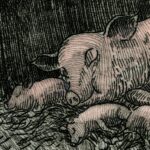Arthur Geisert’s pigs are legendary in the world of children’s books. They carve ice sculptures, teach Roman numerals, create ingenious machines, and destroy an entire house with spilled milk. If you didn’t know better you’d guess Geisert was born and raised in the mid-west because of his fascination with pigs. In fact, he grew up in Los Angeles and lived in Carmichael for a short time while teaching at the Fair Oaks Lutheran School on San Juan Avenue. “I had never seen a pig until I was grown up,” he says.
Trained as a sculptor in college, Geisert learned to etch at the Otis Art Institute in Los Angeles. “I like it because it’s sculptural, and because of its graphic quality,” he says. Early in his career, Geisert etched in his spare time enjoying some success with sporadic sales. Since his etchings contained narrative and humorous qualities, he began submitting stories and illustrations to children’s publishers and received encouraging rejections for ten years. His first big break came at a Boston Print Makers member show where an adult editor from Houghton Mifflin asked to see more of his work and passed it along to the children’s editor.Pa’s Balloon and Other Pig Tales was published in 1984, and he’s published about a book a year for the last 25 years.
Every Geisert picture book is illustrated with etchings. In The Etcher’s Studio, he gives children an inside look into the life of an etcher. The process has changed little since the late 1400s or early 1500s. Geisert scratches his design through a wax coating on a copper plate to expose the shiny copper. The plate is soaked in an acid bath to bite or etch lines into the copper. The length of time in the acid determines the depth of the line etched into the metal. Geisert’s plates need at least three acid baths for basic, intermediate, and fine lines. The plates are inked and rolled through a press, printing the drawing on a piece of heavy etching paper. The final print is then hand-colored. The copper plates for each book take about three months to complete.
Because of the complexity of the etching process, Geisert first constructs a solid story and finalizes the art with his editor. His stories evolve very, very slowly from a steady, constant, total involvement in the work, day in and day out. Geisert starts with simple drawings, and pulls his story together visually—a process that can take six to nine months. “When you finally get something down on paper and begin to see relationships, then one thing leads to another,” he says. Simultaneously, he thinks about the text. When he finally gets to a point where he’s happy with his drawings, the text pours out easily because he’s been living with the drawings for so long. For the wordless books, like Lights Out, many revisions of the art are required to get the action to work smoothly and believably. Geisert’s subtle sense of humor plays a large part in each of his books.
Geisert and his wife, Bonnie, wrote what he calls “the town books” —Desert Town, Prairie Town, Mountain Town, and River Town. Generally Geisert avoids research, but he and Bonnie created a fun way to get the job done. For instance, when researching River Townthey visited all of the small towns on the upper Mississippi River between Davenport, Iowa and St. Paul, Minnesota. They walked the streets, had lunch in town, and purchased post cards at a local shop. One always went to their editor to show him they were on the job. After returning home with photos, sketches, and notes, they created a composite town from the ones they’d visited.
For Roman Numerals I to MM, Geisert drew a total of 4,864 pigs. On the MM page alone, there are 2,000 little farm pigs illustrating the concept that MM equals 2,000. His editor said he wasn’t going to edit that, implying that Geisert was responsible for the pig count. Geisert, in his best imitation of a general dividing territory among his troops, enlarged the preliminary drawings of the book. He marked off zones on each page and created little booklets for his army of counters. Then they met. If everyone counted the same number of pigs in one zone, that was the final count and they moved on to the next zone.
Recently divorced, Geisert moved his studio from Illinois to Iowa. Over the course of his career, he’d accumulated over 1,000 copper plates weighing a total of 10,000 pounds! The Dubuque Museum of Art is now the repository of 700 of these plates; several others were sold for scrap. Geisert’s new home/studio is a 900 square foot bank building built in 1913. After shoring up the floor to accommodate his heavy etching equipment, he moved in. His sleeping quarters are in the old vault. Sleeping near his studio is imperative for Geisert because his workday revolves around biting times. He frequently sticks post-it notes on the television to remind himself when to take a plate out of the acid.
Geisert’s work has appeared in The New Yorker and on the cover of The Horn Book Magazine. Pigs from A to Z and Roman Numerals I to MM were New York Times Best Illustrated Books. But his favorite accolade appealed to his sense of humor. Nursery Crimes was awarded “the most ridiculous plot of the year” by Publishers Weekly!


